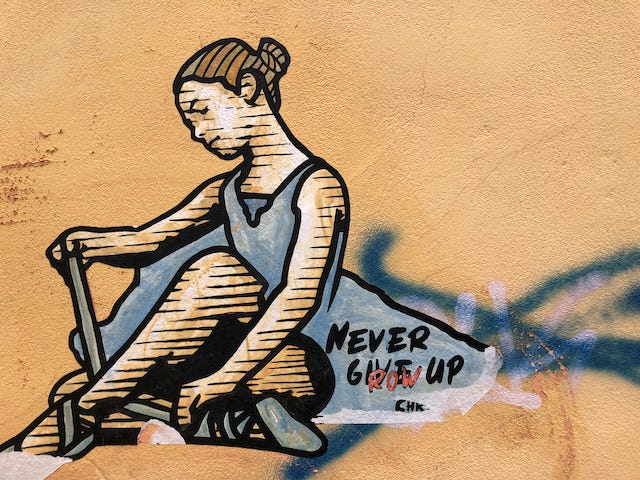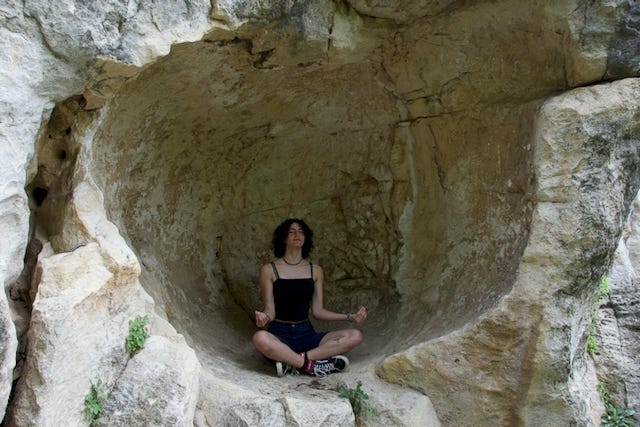When we have a strong demand that a behavior disappear from our life or that something about us needs to change in a specific way, it is too easy to lose sight of the possible gains happening to us in a less explicit way. The demands we have on ourself or our life get in the way of the progress we may be making. With any sort of self work, we need to remember to SLOW DOWN. Moving too fast, expecting too much, or obsessing over one specific result will not create effective personal transformation. There needs to be a check in that goes beyond our limited perspective and opens us to what we are capable of embracing.
It may be good to remember that we all have something about ourselves we’d rather avoid like the plague. All of us have an innate resistance to the truth of who we are. We have stubborn places inside us we do not believe we can change. We have stagnant and closed spaces inside us that reflect beliefs and images about the way the world works that are limited and erroneous. There is a blind aspect inside all of us. When we are blind to something, life is usually giving us exactly what we need and we can’t see it. The place where we have zero awareness of self is a place where we stagnate and cannot grow. In this place, no transformation happens. It is important to give space for this and not try to avoid it or push yourself to transform something you are not ready to look at.
You can transform anything in your life through attention and intention.

Maybe it would be best to assess for a minute why exactly you personally engage in transformation? Discovering your own transformational drive is important to understanding not only what you transform, but how you do it.
I want to acknowledge my personal soul purpose here and say that I believe that engaging in transformation should be about growing our human perspective into a more connected vibration. I also know that this is not the reason so many of us choose to engage in transformation. Most of us do it to fix, repair, or fixate.
If you are engaging in self work with attention and intention based in “What’s wrong with me?” the negative is going to take over your transformational process. You miss the positive elements of your soul.
For those who seek, the whole self needs to be found. It is too easy to base self discovery on the negative. When we read about a self help concept and recognize it inside us, we identify a problem as our own. How do we welcome what’s NOT a problem about ourselves? How de we cultivate a relationship to positive emotions, positive embodiment, and acceptance of the core self? What about the part of self that supports us by just being there as it is? In all things, we need to cultivate a relationship to balance. This is especially true with engaging in taking active steps to transform the self.
First Phase: Awareness!
Do you know? Awareness always has the capacity to create change.

The first step we take in self growth may always first be that step towards feeling the need to fix or repair. As we engage in repair, there is an inevitable unfolding of awareness. We understand conceptually something about ourselves in a new way, with new thoughts, and hopefully with self responsibility (not blame). Balance comes into play when we give room for shadow to arise. Balance also comes into play when we can accept the facets of ourself that are simply connection to core. We support any transformational process by finding our internal ground through connection into our true self.
What we do with awareness decides if anything actually changes. Some of us may have an awareness arise and immediately resist it. Some of us might become overwhelmed by awareness. I notice a lot of people who want to push through awareness, having too many happen at once and losing the actual process of moving through anything as a result. This is what I call a negative loop. Awareness addiction. Awareness without self responsibility is awareness that does not change anything. There is a common trap where we get to say we are doing self work, without moving awareness into actualization.
Remember: We need OTHER PEOPLE to heal. Awareness needs to be finessed. It grows with developing insights about an awareness through how we relate to others, not simply how we relate to our self.
One step at a time, we open to parts of ourselves to achieve change. Of course this is easiest to do with things that are going “wrong.” We all have consistent negative interactions, unwanted emotions, or cyclical wounded loops. When we feel like we need to have them in our life or cannot escape them, it is time to think about transformation. Getting specific by witnessing the self in a negative pattern is the first part of building awareness. Slow down here. Keep it simple. Learn how you are and who you are. Awareness may be the first step, but self reflection has to follow.
Second Phase: Non Judgmental Self Reflection.
Self reflection is how we enter into the self responsibility phase in any process of transformation. We have to understand how an awareness specifically applies to us and the consequences that then play out in our lives as a result of the awareness. We need to learn how we interact with others in what we are learning and understanding. Too many awarenesses at once is a detriment to self growth. It makes it so our focus is scattered and overwhelmed.
Building awareness is different than having awareness. Self reflection is required to build awareness.
A great practice for building awareness is to spend time before bed thinking about your day and going through how you felt in the interactions you had with others or even with yourself that build on the awareness you are currently working on. You can categorize emotions, thoughts, and interactions through self responsibility and self ownership (NOT BLAME OR JUDGEMENT).
Ultimately we need to embrace our freedom of choice in any situation we find ourselves in. Acknowledgement of choice to act or react in any situation with more of the self we want to become is a way to observe transformation through the process, not in spite of it.
Self reflection as a practice is not an exercise of blame and fault but one of building a positive witness self that is rooted in compassion. This is where you can exercise your own nonjudgmental observation of self in relationship. Use the lens of whatever awareness you are working with to ask how this part of yourself influenced who you were through out the day.
How were you responsible for interactions that went wrong?What were you feeling?How did you metabolize the actions of others?Where did you lose yourself?How did you defend yourself?What is the driving force behind your actions? Is there a need or truth that is not being expressed?Can you hold space for yourself to learn from your own actions?
Any ritual of reflection with self that includes honesty and compassion will deeply transform how you digest what happens to you. The practice of non judgmental self reflection builds upon the next stage of transformation. Understanding what happens inside you as you go about your day leads to a sense of choice. And choice, my friends, when it comes to transformation, is the game changer.

Third Phase: CHOICE!!!
Choice has subphases. Once we can embrace what we do, why we do it, and question it, we can begin to feel like we could act or react in an unfamiliar way. THIS is how we break patterns, which is ultimately what transformation is all about. We can range in any situation from feeling like we have choice in the moment and choosing differently (which is the demand we will tend to put on ourselves to label something as “transformed”) to realizing we could have chosen something different after the fact to not feelings a sense of choice at all.
Choice requires patience. We need to be able to mess things up again and again without judgement in order to be interested in the effects of any choice we make.
In any given situation, choosing requires a cultivated ability to self reflect, build awareness, and experiment with how we react. Without understanding what we are choosing or how we are making a choice, we are too blind to the self we want to transform to do anything but feel like life is happening to us. With choice, we can start to embrace how to happen to our own life.
For example, having awareness after something has happened means we might not be able to change our behavior in the moment or know how to choose something new. We can notice something didn't go well but not have enough clarity to understand what different choice we could make. We need to build awareness in these cases. We have to self reflect when we aren’t actively engaged in a negative situation. We could consider looking at emotional states, triggers, defenses, negative pleasure, negative identities, limiting images about reality, and thought patterns to get more clarity of why we are choosing to engage in a loop that is harming instead of healing us.
More detailed self reflections in a negative interaction allow us greater ability we have to see the complexity of self that is causing a behavior and make different choices.
As we look inward and self assess more, we start to be able to witness our actions in the moment. It’s a huge demand on ourself to think that we are always going to make the choice to be who we want to be. We have to give space to NOT figure out how to change our actions or reactions in the moment Pressure to be perfect creates a deepening of the “What is wrong with me?” mindset.
One of the more complicated places in self development occurs when we feel like we have the awareness, we notice ourselves engaging in an old behavior, but we still cannot change because either our understanding is inconsistent, our emotions take over, or we are unable to know how to choose differently. I have noticed that this is often the place where many people give up or get depressed. We are so close to change, and yet we need a bit more self reflection, a bit more self awareness, a bit more understanding of what is going on in order to create a different reality. Be patient. Now is not the time to give up. Get a bit more clear.
Ask yourself how are you avoiding change and why? This is the place where you have to look at negative pleasure. This one can be hard to admit - how are you enjoying the negative experiences that come your way? What part of your being says maybe, "this is what you deserve" or "see? I told you you aren't good enough." You might need to own the part of you that wants to stay the same because it is more comfortable than embracing choice.
Fourth Phase: Self Actualization.
Self actualization occurs when we have an awareness, we understand what is fueling this awareness, and we stop ourselves from responding in a familiar way.
Often this stage is related to the ability to try something new, to be vulnerable, to step into the unknown. The uncomfortable action or new response is the way to move into the next step of self growth, self actualization. When we have become self actualized into an awareness, we stop responding in the old way and start to listen to a different voice or current inside ourself. We expand our sense of self and strengthen our relationship to a healthy ego. We take risks and notice the results. At first this might feel a bit rusty, but over time it gets easier. Eventually we can move on to a new awareness and start the process all over again.
I have to say that this phase is incredibly empowering. This is where we feel like we are part of our lives, not a victim to it. When we can self actualize through making new action steps in life, we transform who we are. We become. This step, to me, creates self help addicts in a positive way. We learn how to be who we want to be and that anything in life can be changed if we bring our full self into any situation. This phase is not about control. It is about deep self acceptance and a connection to life that goes deeper than “what’s wrong with me?'“ into expressing our unique being no matter what happens to us.

It is important to mention again the role of unconscious and shadow. There are always things we don't know about ourselves. These are places we might want to look at but do not have the awareness of ourselves that is necessary to do it. Since shadow and unconscious always play a part in self actualization, our journey never ends.
Once we start looking at ourselves and trusting the role of the unknown in life, we can use what life is presenting to us as a way to open into the next step of our journey. Rather than resist, it is important to recognize that transformation is a life long, constantly unfolding process with no goal beyond a deeply embodied life that we get to navigate with clarity and deeper connection - if we choose.
Let's just reiterate the stages with a bit more detail.
No awareness.
Conceptual awareness from which to explore the self.
Exploring awareness after an interaction with another. Open to a possibility of something new happening but still not able to make new choices.
Recognizing what is happening after an interaction but still feeling
unclear what different choices could be made.
Experiencing what is happening in the moment with awareness but
that awareness is inconsistent and/or there is still no sense of choice.
Experiencing what is happening in the moment with awareness that leads to a sense of choice.
Consistent ability to change an interaction in the moment to something
new . The ability to make a choice through awareness and positive intent.
Effortless behavior shift. A new way of being has occurred and movement from that point is aligned.

Photo Credit: dr.joe.rothstein
Remember that transformation takes time. Be patient. Go slow. Self growth is the truth your being needs. Keep trying.
Keep reading with a 7-day free trial
Subscribe to mindfullynessa to keep reading this post and get 7 days of free access to the full post archives.


